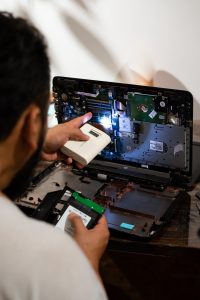Point-of-sale (POS) systems have become an essential technology for businesses of all sizes looking to streamline operations, better manage inventory, and enhance customer engagement. With the right POS solution, companies can achieve new levels of efficiency while gathering valuable data insights into customer behavior and sales trends. This allows businesses to make data-driven decisions to increase profits.
In this blog post, we’ll explore the key benefits of POS systems, the different types of solutions available, and effective strategies to integrate your POS with other business automation tools. With the right approach, you can leverage POS technology to power smarter, smoother business operations.
The Benefits of POS Systems
For many businesses, implementing a POS system is one of the smartest investments they can make. When combined with the right hardware and software configuration for your needs, a POS system can provide the following game-changing advantages:
Streamlined Transactions
A POS system greatly simplifies the checkout process for both customers and employees. Cashiers can quickly scan barcodes or use touchscreen interfaces to add items, apply discounts/taxes, and process payments. Customers can pay with cash, credit/debit cards, or other methods like Apple Pay. This creates fast, convenient transactions compared to manual calculation and record-keeping. Enhanced Inventory Management
POS software gives retailers and restaurants real-time visibility into critical inventory data. As items are sold, inventory levels update automatically. Managers can set par levels and be alerted when stocks of a particular product run low. This allows for smarter purchasing and prevents out-of-stocks. Some POS systems also assist with purchase ordering and inventory transfers across multiple locations.
Powerful Reporting and Analytics
The data captured in a POS system provides invaluable insights through robust reporting and analytics capabilities. Owners and managers can track key metrics like sales volumes, customer traffic, employee performance, and more. By understanding this data, businesses can identify opportunities for growth, address problems areas, and tailor offerings to customer buying patterns.
Improved Customer Experiences
With streamlined transactions and inventory accuracy, POS systems enable businesses to deliver excellent customer experiences. Features like loyalty programs integrated into the POS further enhance customer engagement. Retailers can also leverage data from the POS to provide personalized promotions and offers to buyers. This drives repeat business and increased sales.
Omnichannel Selling
A POS system facilitates omnichannel sales strategies by integrating both in-person and online channels into one unified solution. This allows customers to place online orders for in-store pickup or delivery. It also lets retailers fulfill online orders using in-store inventory. This integration provides shoppers with flexibility while giving retailers visibility across all sales channels.
Types of POS Systems and Hardware
With an understanding of the potential benefits, choosing the right POS solution for your business is essential. There are several core considerations when evaluating different POS systems and hardware options:
Traditional/Legacy POS
Traditional POS systems use a central terminal in a fixed checkout location. This offers robust features and stability but lacks mobility. Legacy POS systems are best suited to businesses with checkout counters like retail stores, restaurants, and grocery stores.
Traditional POS hardware includes:
– All-in-one terminal – Combines register, monitor, receipt printer, cash drawer, card reader etc. into one device.
– Individual components – Allows mixing and matching distinct register, printer, scanner etc.
– Desktop or stand options – Ranging from small counters to large kiosks.
– Peripheral hardware – Barcode scanners, PIN pads, kitchen printers, and more.
Mobile POS
Mobile POS solutions use tablets, smartphones, or specially designed handheld devices to allow transactions anywhere in a store or restaurant. This enhances customer experiences with line-busting and tableside ordering capabilities. Mobile POS options work best for businesses like restaurants, boutiques, field services, events, transportation, and delivery.
Mobile POS hardware includes:
– Smart tablets and phones – iOS, Android, and Windows-based options.
– Dedicated mobile POS devices – Portable all-in-one units designed for POS use.
– Mini receipt printers – Bluetooth, WiFi, or dongle-connected mobile printers.
– Payment terminals – Accept payments using wireless card readers or chip readers.
Cloud-Based vs. Local POS
Cloud-based POS systems store data on remote servers accessed online. This allows management and access from any location, but depends on internet connectivity. Local POS systems store data onsite and can operate offline but have limited remote access and scalability.
Most modern POS solutions offer a hybrid model balancing the benefits of both approaches. When evaluating options, consider your business connectivity, management requirements, and scale.
Additional POS Hardware
Beyond core registers and payment processing devices, businesses can benefit from specialized POS hardware like:
– Barcode scanners – Accurately ring up products by barcode much faster than manual entry.
– Label printers – Print shelf or product labels and signage.
– Kitchen printers/displays – Send orders from counter to kitchen in restaurants.
– Self-service kiosks – Let customers place orders themselves to minimize queues.
– Digital menu boards – Display dynamic menus that are easy to update.
– Cash drawers – Securely store cash and organize bills/coins.
– POS scales – Weigh produce and other sold-by-weight items.
Choosing Your POS Solution
With many POS options on the market, selecting the right solution takes careful consideration of your business requirements, budget, and growth plans. Here are some best practices to follow when evaluating POS systems:
Assess Your Specific Needs
Avoid generic, one-size-fits-all POS systems that overload you with unnecessary features. Carefully assess your must-have features based on your specific business model, sales process, and pain points:
– Do you need invoice/estimate capabilities?
– Will you offer delivery? Require a driver app?
– What types of payment do you need to accept?
– How many terminals/registers are required?
– What reports and analytics matter most?
This focuses your search on systems tailored for your needs.
Consider Scalability
As your business grows, your POS needs will evolve. Seek systems that make it easy to add locations, users, and new capabilities as needed. Cloud-based solutions are typically most scalable. But some local systems also allow for expansion.
Evaluate Integrations
The more systems your POS seamlessly syncs with, the more it can unify your business operations. Assess potential integrations for accounting, ecommerce, CRM, inventory, loyalty programs, and other systems you use. Modern APIs make this integration simpler but verify options before choosing a POS.
Compare Top Contenders
Once you’ve narrowed your search to the top solutions, compare them head-to-head. Weigh the pros and cons of pricing models, hardware bundles, feature sets, integrations, and service options. If possible, request demos to experience the POS interface and workflows firsthand.
Consider Future Needs
While focusing on your current requirements, avoid shortsighted decisions that box you into a POS system. Seek scalable solutions with flexibility to accommodate changes so that your investment serves your business for the long-haul.
Integrating Your POS for Smarter Operations
To truly maximize the potential of your POS system, integration with other business software is essential. Combined with accounting, inventory, CRM, ecommerce, and other systems, your POS can centralize your data and unify operations for smarter, more profitable business management.
POS & Accounting Software
Linking your POS to your accounting software allows the financial data captured in transactions to automatically flow into your financial reports. This saves significant time, minimizes errors in manual data entry, and provides real-time visibility into sales and profits.
Choose a POS that integrates seamlessly with top accounting platforms like QuickBooks, Xero, or Sage Intacct.
POS & Inventory Management
Connecting your POS system to your inventory management tools enables real-time inventory tracking across both sales and purchasing processes. As the POS records a sale, inventory levels decrement in real-time. Inventory management software can automatically generate replenishment orders as stocks get low.
Target POS solutions that offer robust integrations with leading inventory management platforms like TradeGecko, Cin7, and Fishbowl.
POS & Ecommerce
For unified commerce across online and offline sales channels, integrate your POS with your ecommerce storefront. This allows “buy online, pick up in store” capabilities and gives store associates visibility into online orders for fulfillment. It also ensures inventory levels remain accurate across all channels.
Shopify POS, Vend POS, and Square all integrate beautifully with their respective ecommerce platforms.
POS & CRM Software
Integrating your CRM software with your POS system allows customer transaction data captured at the point of sale to be linked with your central customer profiles and records of engagement. This provides a complete 360-degree view of each customer to enhance loyalty-building.
Choose a POS that easily connects with top CRM platforms like Salesforce, HubSpot, and Zoho CRM.
POS & Marketing Automation
Connecting your POS to marketing automation tools like Mailchimp or Constant Contact lets you trigger personalized email promotions based on customer purchase activity. This could include thank you emails, requests for reviews, or follow-up offers linked to recent transactions.
Target POS systems with strong app marketplaces that support marketing automation platform integrations.
By taking the time to carefully evaluate your business needs, assess POS options, and integrate your point-of-sale seamlessly with other core software systems, you can achieve new levels of operational efficiency, customer intelligence, and data-driven decision making. A POS system unifies your physical and digital operations to help your business thrive. With the right POS approach tailored specifically to your business model, you’ll be positioned to enhance customer experiences, contain costs, and drive sustainable growth.




